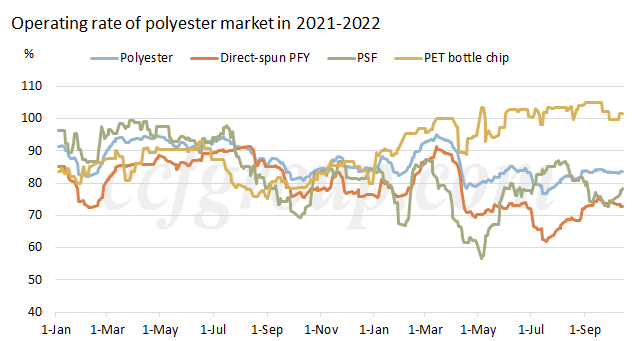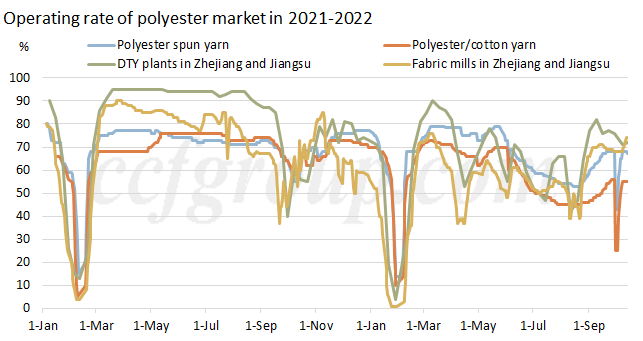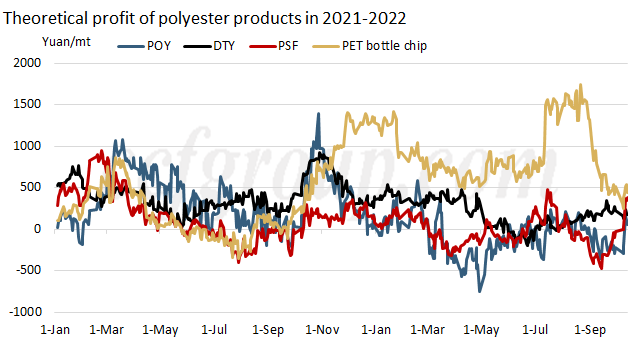Polyester: some questions about the recent market
After the polyester polymerization rate was released last Friday, some market players asked what factors this polymerization rate took into account.
There were diversifications in the market status quo, including the polyester market and downstream sector. The following part is the operation status CCFGroup traced:
Why did polyester polymerization rate increase instead of decrease?
The news of production curtailment kept emerging in Sep, even earlier in Aug. PFY companies faced big inventory burden in 2022. With strong feedstock price in Sep, most polyester companies suffered losses, excluding PET bottle chip producers. Under such circumstance, many factories strongly intended to scale down output. The polyester polymerization rate in Sep also incarnated the production curtailment. Actually, some big companies also slashed outpour in Oct.
However, the production of some polyester companies also obviously increased in Oct.
The circulation of spot PTA was tight in Sep impacted by the typhoon and some other factors. Some polyester companies encountered the pressure from inadequate feedstock and some slashed production. In Oct, the circulation of spot PTA gradually improved. Some units who cut production earlier resumed production, including PSF, PET bottle chip, BOPET and PFY factories.

Some people will ask:
Inventory is so high, why not reduce production?
With regard to this topic, let's put it aside for a while and take a look at another question.
Is end-user business weakening?
According to the survey made by CCFGroup, the seasonal demand for polyester products and end-user demand grew in Aug and Sep. In fact, demand for cotton textiles and other fibers also witnessed similar trend.

Downstream market was not as bad as imagined after the National Day holiday. Knitted fabric market performed well. Warp knitting plants in Haining and circular knitting mills in Xiaoshan and Shaoxing saw good business. Warp knitting plants in Changshu also saw better status instead of under sluggishness before holiday. However, demand for water-jet fabrics remained bad in Wujiang, Jiangsu and dyeing plants in Shengze, Jiangsu also witnessed slack business. The operating rate of synthetic filament fabric printing and dyeing plants increased to 80%. The production needed to queue in some dyeing plants. In general, downstream market was divided now. Knitted velvet fabric performed better than woven plain fabric. End-user demand had some resilience.
Only to sustain resilient for a short period
The status quo of recent polyester market can be described as: expected to weaken soon but has resilience in reality.
Demand cannot be simply described as bad now as there is resilience. It is not necessary to revise down the polymerization rate to below 80%. After all, the polyester polymerization rate has sustained low for a long period. The polyester polymerization rate seemed to be not low if looking at the absolute run rate alone, while the polyester production decreased by 2.3% on the year in Jan-Sep, 2022, which has been extremely rare.
So back to the previous topic: inventory pressure is so great, why resume production?
The inventory burden is a problem polyester companies encountered but it may be not the unique problem. High inventory has been a normality of the market amid weak demand in 2022. It may be hard to back to low inventory as it needs the cooperation of supply and demand factor. In addition, the inventory pressure is different in various factories.
Players of many links face big pressure this year. MEG plants also encounter great pressure under losses. For companies who run normally, it can suspend production periodically but it can't stop for long. When the market prosperity is bad, companies would pay more attention to achieve better performance rather than just simply suspend production.
Stocks of grey fabrics are reducing now and demand may sustain moderate in Oct. Downstream plants do not cut more production temporarily. Polyester companies also do not given up temporarily.
Actually, the feedstock supply sees friendlier environment than Sep.

However, the polyester polymerization rate only does not reduce as greatly as anticipated. It is hard to advance too. How long it will last remains uncertain.
- Top keywords
- Cotton Price
- Cotton Futures Price
- Cotton Futures
- CZCE
- PTA Futures Price
- Chemical Fiber
- Polyester Prices
- Wool price
- PTA Futures
- Shengze Silk
- China
- Yarn Price
- price
- China Textile City
- Fibre Price
- Benzene Price
- Cotton
- Index
- Cotton Index
- PTA
- fabric price
- NYMEX
- Top 10
- textile industry
- Spot Cotton
- Cotton Yarn
- Polyester Price
- Futures
- PTA Price
- cotton yarn price

